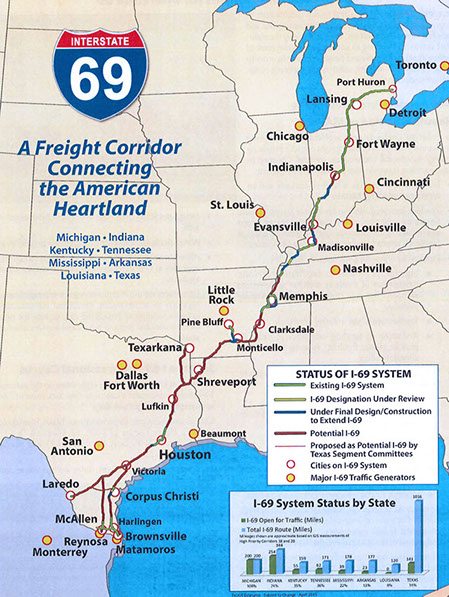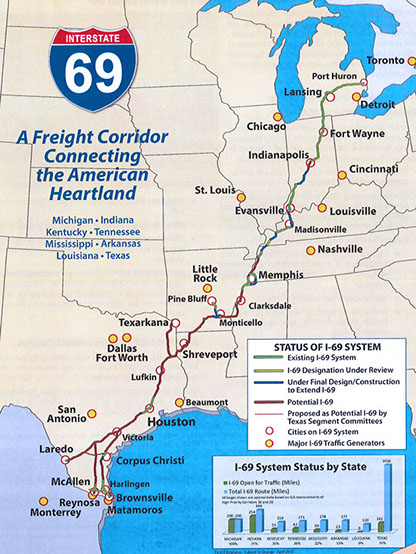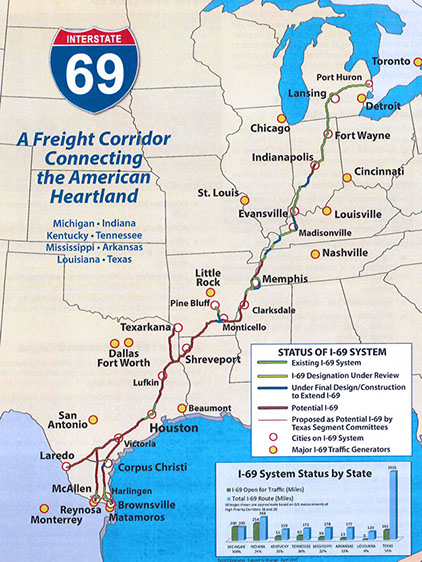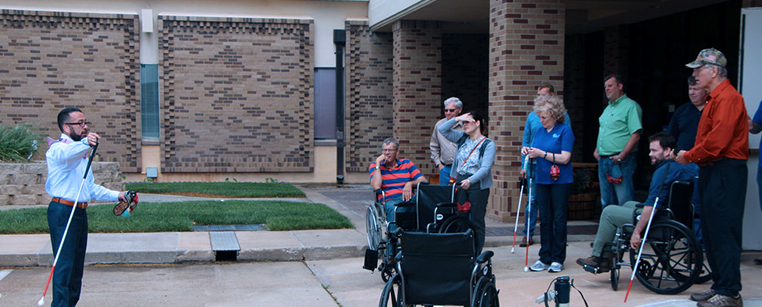Across the country, Resource Center staff demonstrate a steadfast commitment to State partners–providing technical assistance to projects that improve mobility and roadway safety, support economic growth, and enhance the movement of goods and services.

Resource Center Teams Called to Action in 2017 Hurricane Season
As the 2017 hurricane season wreaked havoc and devastation in the United States, several Resource Center teams supported interagency efforts to coordinate safe evacuations and provide emergency assistance to millions.
CLICK TO READ

Working Together, RC Teams Help DOT Advance I-69 Corridor in Indianapolis Area
Interstate 69 is designated as one of six “Corridors of the Future,” representing a primary north-south artery for the movement of goods and services across the United States. The Resource Center and FHWA’s Indiana division office are contributing to several major projects in the greater Indianapolis area to reduce congestion and improve the efficiency of freight delivery along I-69.
CLICK TO READ

RC Teams Collaborate to Implement Transportation Performance Management
Transportation Performance Management (TPM) was intended to transform the Federal surface transportation program by focusing on performance outcomes, increasing transparency, and improving project decision making. Implementing TPM doesn’t always come easy, so the Resource Center teams are working collaboratively to support transportation agencies across the Nation.
CLICK TO READ

Federal-aid Essentials Influences Development of ADA/Section 504 Videos
The success of FHWA’s online video library, Federal-aid Essentials, has spurred the development of similar projects in the agency, most recently the creation of an on-demand video series on the Americans with Disabilities Act/Section 504 requirements. Three Resource Center teams are playing essential roles to make that happen.
CLICK TO READ



Resource Center Teams Called to Action in 2017 Hurricane Season
Always on call, OTS’s full cadre of Resource Center engineering and transportation professionals stands ready to help States meet tough transportation challenges as they arise. This was never more evident than during last fall’s busy hurricane season, when not one, but four hurricanes pummeled various sections of the country. Throughout the storms, RC teams provided behind-the-scenes support, assisting FHWA division offices in providing critical disaster relief services to State departments of transportation (DOT) and local communities.



Coordinating Safe Evacuations ahead of the Storms
RC Operations mobilized its Evacuation Liaison Team (ELT) to help with evacuation coordination and routing at the onset of Hurricanes Harvey, Irma, and Nate. The ELT, fully staffed by RC Operations team members, collaborated with the Federal Emergency Management Administration (FEMA) to coordinate communications between State and Federal emergency management and transportation officials, to advise and support mass evacuation efforts.
Throughout the hurricane season, the ELT provided support to evaluate conditions and distribute real-time information on evacuation decisions and traffic flows. RC Operations team members stationed in Atlanta, Georgia contributed their traffic management expertise onsite at FEMA’s Regional Response Coordination Center. They worked with their FHWA division and State DOT counterparts throughout the southern region to assess
traffic flow volumes, traveler information systems, and road closure information.
It is estimated that the total number of evacuees from Hurricane Irma was the highest ever recorded. Despite packed roads, excellent coordination and phasing kept evacuation traffic flowing prior to Irma making landfall. This year, the ELT team supported State partners as they considered the use of part-time shoulder lanes. Texas and Florida chose to employ this method, thereby providing increased capacity on major evacuation routes.
In 2017, the ELT was part of the Federal team recognized for the Secretary of Transportation’s Partnering for Excellence Award for its outstanding efforts in responding to Hurricane Matthew in 2016.
Assisting in the Aftermath of Hurricane Disasters
RC staff also provided expert assistance in the aftermath of the storms. In 2017, the RC’s Structures team, along with the Geotechnical and Hydraulic Engineering team, provided on-call assistance to FHWA divisions and State DOTs as they assessed the structural safety of bridges in the aftermath of the devastating hurricanes. The Environment and Realty team supported the divisions with emergency disaster inspections, supplementing division staff both in their offices and at emergency operations centers. RC personnel also helped staff emergency support positions at FEMA facilities and represented FHWA and USDOT at emergency meetings. Members of the Finance Services team and the Pavements and Materials team continue to provide support and services in the aftermath of Hurricane Maria.
Providing Emergency Relief Resources
To help State and local authorities understand Emergency Relief (ER) procedures, the Resource Center produced four ER videos, available through the Federal-aid Essentials online library. Following this year’s hurricane season, the Construction and Project Management team prepared an Emergency Relief Package, which provided the ER videos on USB drives to division offices. The Operations team also shared the videos through FEMA’s Emergency Support Function (ESF-1) structure. FHWA division offices found the USB drives to be an effective method for distributing ER procedures and resources in outreach meetings with State and local agencies.
Emergency Relief videos are available on the Federal-aid Essentials website at:
https://www.fhwa.dot.gov/federal-aidessentials/catmod.cfm?category=overview



Working Together, RC Teams Help DOT Advance I-69 Corridor in Indianapolis Area
For more than two years, four RC teams–Air Quality, Freight and Transportation Performance Management, Operations, and Safety and Design–have supported the Indiana Department of Transportation (INDOT) by providing technical expertise and assistance on many complicated facets of the I-69 projects. Two of these projects, Interstate 69 Section 6 and State Route 37, are at key stages in development. INDOT is employing cutting-edge innovations in the design and construction of I-69 and SR 37. Technical assistance from the four RC teams, working with researchers from FHWA’s Geometric Design Lab at the TurnerFairbank Highway Research Center, contributed to significant progress moving Indiana’s projects forward in 2017.
The $1.45 billion I-69 Section 6 project is the final section of the I-69 corridor between Evansville and Indianapolis, converting 26 miles of existing SR 37 to new interstate route I-69. Access will be accommodated through nine new interchanges and several overpasses. The northernmost interchange is a new system interchange with I-465, the beltway around Indianapolis. The Environmental Impact Statement (EIS) and preliminary engineering work are nearly complete, and this project is rapidly moving toward anticipated construction in the summer of 2019.
In addition to the national benefits associated with this project, INDOT has high expectations that the new I-69 between Evansville and Indianapolis will be a key component to the future vitality of southwestern Indiana, improving access to jobs, education, and healthcare.



The State Route 37 Mobility Study
In a related project, Indiana conducted the SR 37 Mobility Study. Indiana DOT, the Indianapolis Metropolitan Planning Organization, Hamilton County, the Town of Fishers, and the City of Noblesville collectively identified needed improvements to SR 37. Upgrades to the SR 37 corridor will extend from 126th Street (approaching its interchange with I-69 to the south) to its northern terminus at SR 32/SR 38. The study area also extends along 146th Street from Allisonville Road to Cumberland Road.
The project identifies approximately $350 million in overall roadway improvements and grade separation work, funded 80 percent by FHWA through transfer of State reserved funds from INDOT. The remainder is locally funded by the Fishers, Noblesville and Hamilton communities or governments. This project is designed to support economic growth, mobility and safety needs, and improve the quality of life for area residents and commuters. FHWA will provide ongoing technical assistance and review services.
Specialists from multiple RC teams are coordinating on these projects of regional and national importance. From traffic and safety analysis and simulation modeling to interstate access documentation, the RC teams respond with timely assistance, working across organizational boundaries to advance these projects.
RC Teams Collaborate to Implement Transportation Performance Management
Training, technical assistance, and tools are key components of FHWA’s corporate implementation of Transportation Performance Management (TPM). The Resource Center (RC) helps lead and support the agency’s outreach efforts to external partners and internal staff, working in partnership with headquarters (HQ) offices. The RC’s new Freight and TPM team is the agency’s coordination point for all TPM activities, as well as the lead within the RC on cross-cutting TPM topics and requirements. This new structure allows the RC to be increasingly responsive and focused on emerging transportation program and partner needs.



TPM is a strategic approach that uses system information to make investment and policy decisions to achieve national performance goals. In 2012, MAP-21 (the Moving Ahead for Progress in the 21st Century act) included provisions that are transforming the Federal surface transportation program into one focused on the achievement of performance outcomes. FHWA implemented several rulemakings in support of the MAP-21 requirements, specifically in the national goal areas of safety, asset management, infrastructure condition and congestion/freight.
In implementing TPM, the RC Freight and TPM team coordinates with multiple RC teams–Pavement and Materials, Structures, Safety and Design, and Operations. In 2017, RC teams were proactive and instrumental in bringing TPM technical services to transportation agencies across the country. They provided valuable technical support and leadership in the development and delivery of a wide array of technical services in support of TPM implementation:
Technical and instructional support for FHWA PM2/PM3 regional implementation workshops During the summer of 2017, multiple RC teams helped FHWA HQ deploy four regional implementation workshops for State DOTs, metropolitan planning agencies (MPO), and FHWA staff. The workshops included presentations on the Asset Management, PM2 (Infrastructure Condition) and PM3 (Congestion/Freight) final rulemakings and associated requirements. In several program areas, FHWA HQ and RC partnered to develop and deliver workshop sessions to nearly 500 attendees. RC staff also captured feedback and key partner questions to support additional corporate discussions on new strategies and resources to support TPM implementation.
Development and delivery of new TPM National Highway Institute (NHI) courses
Multiple RC teams collaborated on the development of more than 10 new NHI training courses on various TPM and Asset Management topics. Cross-team communication and coordination in the RC helped improve the technical content and instructional approaches for these critical foundational courses. The RC now leads the delivery for the majority of these courses. As of October 2017, the RC helped lead delivery of nearly 40 offerings of the NHI TPM foundational courses.
Program-specific TPM resources
RC teams share information on strategies and approaches that better support partner needs in meeting specific program requirements. For example, in 2016 and 2017, the RC Safety and Design team served a key role in delivering more than 40 safety target setting workshops for State DOTs and MPOs to assist these partners in meeting the safety performance management requirements. Since the safety rule was implemented first, the experience and feedback from the RC Safety and Design team was extremely useful for FHWA and other RC teams.
Supporting FHWA division needs
RC teams also develop and deliver training and technical resources to FHWA Division staff through national webinar sessions and discipline activities. For example, the RC Operations team led a discussion on the PM3 rule making (congestion and freight) during the September 2017 Operations Learning and Development Seminar. While the transition to a fully performance-based transportation program continues to evolve, RC efforts will ultimately support the broader national goals of a higher performing, more efficient transportation system. With national goals, measures, and targets – performance management helps set a pathway forward for FHWA and the agency’s transportation partners to save lives, time, and money.
While the transition to a fully performance-based transportation program continues to evolve, RC efforts will ultimately support the broader national goals of a higher performing, more efficient transportation system. With national goals, measures, and targets, performance management helps set a pathway forward for FHWA and the agency’s transportation partners to save lives, time, and money.



Federal-aid Essentials Influences Development of ADA/Section 504 Videos
Now entering its fifth year, Federal-aid Essentials (FAE), has transitioned into a full-scale, expansive transportation resource. The FAE site began with the fundamental concept of streamlining intricate regulations into easy-to-understand visual concepts–Federal-aid Simplified.
For example, the Office of Infrastructure is developing a video series to educate people on the requirements of the Americans with Disabilities Act/Section 504. Team members from the Civil Rights, Safety and Design, and Construction and Project Management (CPM) teams are serving as subject matter experts in the production of the videos, providing technical support and assistance. Education on these requirements is essential to make public rights-of-way safer and more accessible for pedestrians of all abilities.
Additionally, the RC provides leadership by participating in an FHWA working group to address ongoing questions and challenges to meeting ADA/Section 504 requirements. The working group is also comprised of members from the division offices and the headquarters offices of Infrastructure, Planning, Operations, Civil Rights and Chief Counsel. The group addresses issues and works to develop an appropriate and consistent response–and, in some cases, publish policy guidance.



















































